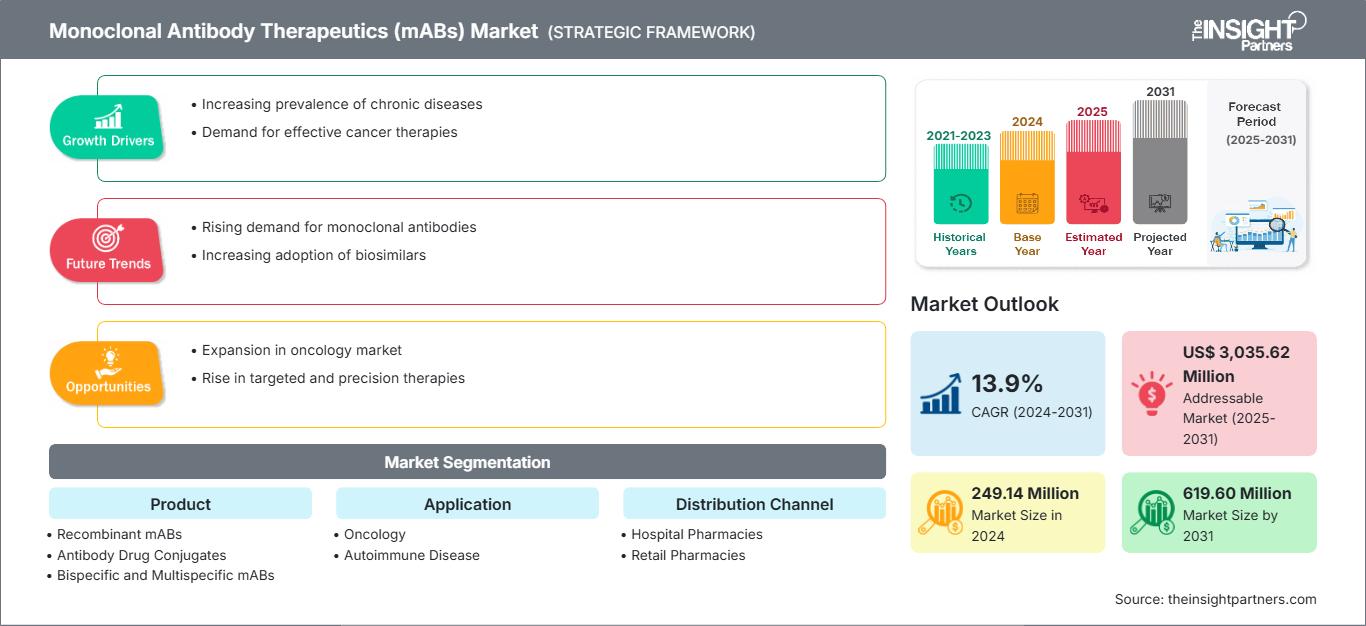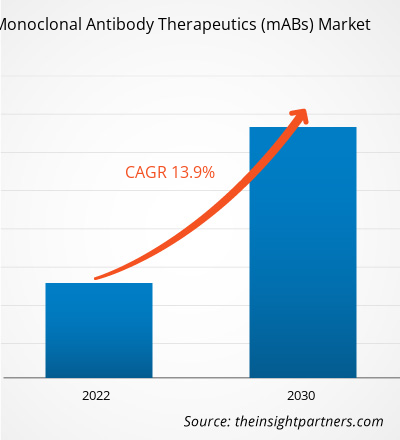Der Markt für monoklonale Antikörpertherapeutika (mABs) soll von 249,14 Millionen US-Dollar im Jahr 2024 auf 619,6 Millionen US-Dollar im Jahr 2031 wachsen; für den Markt wird zwischen 2025 und 2031 eine durchschnittliche jährliche Wachstumsrate (CAGR) von 13,9 % erwartet.
Markteinblicke und Analystenmeinung:
Intensive Forschung und Entwicklung sowie die zunehmende Verbreitung chronischer Krankheiten werden die Marktprognose für monoklonale Antikörpertherapeutika (mABs) in den nächsten Jahren voraussichtlich erheblich beeinflussen.
Ein Medikament auf Basis monoklonaler Antikörper (mAbs) ist eine homogene Sammlung von Antikörpern mit Spezifität gegenüber ausgewählten Zielantigenen. Der Produktionsprozess therapeutischer mAbs erfordert ein Säugetier-Expressionssystem, das die Zellmaschinerie bietet, die für die Glykosylierung, Faltung, Ausrichtung und kovalente Bindung von Antikörperpeptidketten zur Herstellung vollständiger und biologisch funktionaler Moleküle unerlässlich ist. Neue Modalitätsantikörper wie bispezifische und trispezifische Antikörper erkennen mehrere Epitope auf einem einzelnen Antigen, während Einzeldomänenantikörper leichter in Gewebe eindringen können. Solche fortschrittlichen Antikörpertypen können die Effizienz der Antikörpertherapeutika steigern und so ihre Anwendungsgebiete erweitern. Diese Antikörper können auch Antikörper-Wirkstoff-Konjugate bilden, um die Effizienz von Chemotherapeutika bei der Targeting spezifischer Zelltypen zu verbessern. Die Produktion von mAB-basierten Medikamenten zur Behandlung verschiedener Krankheiten treibt die Marktentwicklung voran. Innovative Produkteinführungen durch strategische Entwicklungen der Hersteller bieten lukrative Marktchancen. Darüber hinaus stellen Kombinationspräparate mit mABs einen Markttrend für den Markt für mAbs-Therapeutika dar.
Markttreiber
Produktion von mAB-basierten Medikamenten zur Behandlung verschiedener Krankheiten treibt das Marktwachstum an
Monoklonale Antikörpertherapeutika (mABs) werden zur Behandlung einer Vielzahl von Krankheiten eingesetzt, darunter Krebs, Autoimmunerkrankungen und Stoffwechselerkrankungen. Solche von biopharmazeutischen Unternehmen und wissenschaftlichen Forschungsinstituten hergestellten Medikamente haben aufgrund ihrer hohen Spezifität, starken Zielgenauigkeit sowie geringen Toxizität und Nebenwirkungen auf dem Weltmarkt große Aufmerksamkeit erlangt. Daher wird erwartet, dass eine Steigerung der Produktionskapazitäten für mAB-Therapeutika das Marktwachstum für monoklonale Antikörpertherapeutika (mABs) vorantreiben wird.
In der Europäischen Union (EU) und den USA zugelassene therapeutische mABs
Produkte |
Markenname |
Krankheitsindikation |
Zulassungsjahr: EU |
Zulassungsjahr: USA |
|
Pozelimab |
VEOPOZ |
CHAPLE Krankheit |
NA |
2023 |
|
Elranatamab |
Elrexfio |
Multiples Myelom |
2023 |
2023 |
|
Rozanolixizumab |
RYSTIGGO |
Generalisierte Myasthenie gravis |
2024 |
2023 |
|
Talquetamab |
TALVEY |
Multiples Myelom |
2023 |
2023 |
|
Epcoritamab |
EPKINLY |
Diffuses großzelliges B-Zell- Lymphom |
2023 |
2023 |
|
Mirikizumab |
Omvoh |
Colitis ulcerosa |
2023 |
2023 |
Quelle: Antibody Society
Marktchancen
Innovative Produkteinführungen durch strategische Entwicklungen der Hersteller
Organische Entwicklungen wie Produkteinführungen der Hersteller therapeutischer mABs werden den Markt für monoklonale Antikörpertherapeutika (mABs) in den kommenden Jahren wahrscheinlich stärken. Im März 2022 gab Adagio Therapeutics, Inc. die Markteinführung von ADG20 (ADINTREVIMAB) bekannt. Das neu eingeführte Produkt ist der erste monoklonale Antikörper, der die primären Endpunkte mit statistischer Signifikanz in der Prä- und Postexpositionsprophylaxe sowie der Behandlung von COVID-19 erreicht hat, indem er eine US-Notfallzulassung (EUA) beantragt hat.
Darüber hinaus würden anorganische Entwicklungen wie Fusionen und Übernahmen zur Einführung neuer therapeutischer mABs führen. So gab Elli Lilly im Juli 2023 die Übernahme von Versanis bekannt, einem privaten biopharmazeutischen Unternehmen in der klinischen Phase, das sich auf die Behandlung kardiometabolischer Erkrankungen spezialisiert hat. Elli Lilly erwarb Versanis, um Zugang zu seinem Kernproduktportfolio zu erhalten, darunter ein monoklonales Antikörperprodukt namens Bimagrumab. Dieses Produkt wird derzeit in der „BELIEVE Phase 2b-Studie“ als eigenständiges Molekül geprüft. Es wird auch in Kombination mit Semaglutid auf sein kombiniertes Potenzial untersucht, die Fettmasse zu reduzieren, die Muskelmasse zu erhalten und bessere Patientenergebnisse bei Menschen mit Adipositas und Adipositas-bedingten Komplikationen zu erzielen. Die oben genannten Faktoren sind für das einflussreiche Marktwachstum bei monoklonalen Antikörpertherapeutika (mABs) in den kommenden Jahren verantwortlich.
Markttrends bei monoklonalen Antikörpertherapeutika (mABs)
Kombinationspräparate mit monoklonalen Antikörpern (mABs)
Laut dem Bericht des National Institute of Health (NIH) von 2021 haben die Pharmaunternehmen Roche und Regeneron die klinische Studie Phase 2/3 eingeleitet, um kombinierte monoklonale Antikörper für Patienten mit leichtem bis mittelschwerem COVID-19 zu untersuchen. Sie untersuchen „REGN-COV2“, ein Medikamentencocktail aus der Kombination zweier monoklonaler Antikörper – Casirivimab und Imdevimab – zur Behandlung von COVID-19. Die Unternehmen erwarten, dass die Kombination dieses mAB-Medikaments die Krankenhausaufenthalte um 70 % reduzieren und bei Kindern über 12 Jahren (mit einem Körpergewicht von über 40 kg) wirksamer sein wird. Forscher suchen intensiv nach weiteren solchen therapeutischen Kombinationen monoklonaler Antikörper. Beispielsweise haben die von Elli Lilly entwickelten Medikamente Bamlanivimab und Etesivimab im Jahr 2022 positive klinische Ergebnisse bei COVID-19 gezeigt. Daher werden Kombinationsmedikamente monoklonaler Antikörper zur Behandlung mehrerer Krankheiten in den kommenden Jahren stark an Bedeutung gewinnen und sich zu einem wichtigen Trend auf dem Markt für monoklonale Antikörpertherapeutika (mABs) entwickeln.
Passen Sie diesen Bericht Ihren Anforderungen an
Sie erhalten kostenlos Anpassungen an jedem Bericht, einschließlich Teilen dieses Berichts oder einer Analyse auf Länderebene, eines Excel-Datenpakets sowie tolle Angebote und Rabatte für Start-ups und Universitäten.
Markt für monoklonale Antikörpertherapeutika (mABs): Strategische Einblicke

-
Holen Sie sich die wichtigsten Markttrends aus diesem Bericht.Dieses KOSTENLOSE Beispiel umfasst Datenanalysen, die von Markttrends bis hin zu Schätzungen und Prognosen reichen.
Berichtssegmentierung und -umfang:
Die Marktanalyse für monoklonale Antikörpertherapeutika (mABs) wurde unter Berücksichtigung der folgenden Segmente durchgeführt: Produkt, Anwendung und Vertriebskanal
Der Markt ist nach Produkten unterteilt in rekombinante mABs, Antikörper-Wirkstoff-Konjugate, bispezifische und multispezifische mABs, Biosimilars und Sonstige. Der Markt für monoklonale Antikörpertherapeutika (mABs) ist nach Anwendung in Onkologie, Autoimmunerkrankungen und Sonstige segmentiert. Der Markt für Autoimmunerkrankungen ist weiter segmentiert in rheumatoide Arthritis, Psoriasis, Colitis ulcerosa und Sonstige. Der Markt für monoklonale Antikörpertherapeutika (mABs) ist basierend auf dem Vertriebskanal in Krankenhausapotheken, Einzelhandelsapotheken und andere segmentiert.
Produktbezogen hielt das Segment der rekombinanten mABs im Jahr 2022 den größten Marktanteil bei monoklonalen Antikörpertherapeutika (mABs). Das Segment Antikörper-Wirkstoff-Konjugate wird im Prognosezeitraum voraussichtlich die schnellste CAGR von 18,5 % verzeichnen. Laut dem Bericht von ACS Publications spiegeln therapeutische rekombinante monoklonale Antikörper den neuesten Stand der biomedizinischen Forschung wider, die sich mit der Planung effektiver Strategien zur Behandlung einer Vielzahl von Krankheiten befasst, für die keine wirksame Behandlung verfügbar ist. Tocilizumab ist ein Beispiel für ein rekombinantes mAB-Medikament, das zur Behandlung von Arthritis, idiopathischer Arthritis und rheumatoider Arthritis (RA) verabreicht wird. Darüber hinaus können rekombinante mABs auch zur Behandlung von Krankheiten wie Autoimmunerkrankungen und Krebs eingesetzt werden. Bevacizumab ist ein Beispiel für einen rekombinanten mAB, der derzeit zur Behandlung von Brust-, Lungen- und Darmkrebs, HIV-1, bakteriellen Toxininfektionen/-reaktionen sowie SARS-CoV-2- und Ebola-Virusinfektionen eingesetzt wird.
Antikörper-Wirkstoff-Konjugate (ADC) sind eine sich schnell entwickelnde Klasse von Therapeutika und eine neue Klasse hochwirksamer Arzneimittel, die auf einer Kombination aus Chemotherapie und Immuntherapie basieren. Laut einem Bericht des NIH basieren ADCs derzeit überwiegend auf Immunglobulin G (IgG), und bisher wurden 13 ADCs von der US-amerikanischen Food and Drug Administration (FDA) zugelassen. Darüber hinaus befinden sich mehr als 90 ADCs in der klinischen Entwicklung/Erprobung.
Sr. Nr. |
Produkt (Zugelassene ADCs) |
Krankheitsindikation |
|
1 |
Mylotarg |
Rezidivierte akute myeloische Leukämie |
|
2 |
Adcetris |
Rezidiviertes Hodgkin-Lymphom und rezidiviertes systemisches anaplastisches großzelliges Lymphom |
|
3 |
Kadcyla |
HER2-positives metastasiertes Krebs |
|
4 |
Besponsa |
Rezidivierte oder refraktäre CD22-positive akute lymphatische B-Zell-Vorläuferleukämie |
|
5 |
Lumoxiti |
Rezidivierte oder refraktäre Haarzellleukämie oder HCL |
|
6 |
Polivy |
Rezidiviertes oder refraktäres (R/R) diffuses großzelliges B-Zell-Lymphom oder DLBCL |
|
7 |
Padcev |
Metastasierter Urothelkrebs |
|
8 |
Enhertu |
Metastasierter HER2-positiver Brustkrebs |
|
9 |
Trodelvy |
Metastasierter dreifach negativer Brustkrebs |
|
10 |
Blenrep |
Rezidivierter oder refraktärer multipler Myelom |
|
11 |
Zynlota |
Großzelliges B-Zell-Lymphom |
|
12 |
Tivdak |
Therapie von rezidivierendem oder metastasiertem Gebärmutterhalskrebs |
|
13 |
Elahere |
Platinresistenter Eierstockkrebs |
Quelle: Single Use Support Article
Daher fördern die behördlichen Zulassungen von ADCs und die laufenden klinischen Studien für Behandlungsansätze für seltene Krankheiten das Wachstum der monoklonalen Antikörpertherapeutika (mABs). Markt für das Segment Antikörper-Wirkstoff-Konjugate im Prognosezeitraum.
Regionale Analyse:
Geographisch betrachtet deckt der Marktbericht für monoklonale Antikörpertherapeutika (mABs) Nordamerika, Europa, den asiatisch-pazifischen Raum, den Nahen Osten und Afrika sowie Süd- und Mittelamerika ab. Im Jahr 2022 hatte Nordamerika den größten globalen Marktanteil bei monoklonalen Antikörpertherapeutika (mABs). Der asiatisch-pazifische Raum wird zwischen 2022 und 2030 voraussichtlich die höchste durchschnittliche jährliche Wachstumsrate (CAGR) verzeichnen. In Nordamerika haben die USA den größten Marktanteil. Beschleunigte Produktzulassungsverfahren für mAB-Therapeutika kommen dem Markt in diesem Land zugute. Bis Dezember 2019 wurden laut einer im Fachjournal BioMed Central veröffentlichten Studie 79 therapeutische mABs von der US-amerikanischen FDA zugelassen. Von den 79 therapeutischen mABs sind 30 für die Krebsbehandlung bestimmt. Im Mai 2021 gab die FDA die EUA für den Einsatz eines neuen therapeutischen mAB – Sotrovimab – bekannt, der für die ambulante Behandlung von Menschen mit schwerem COVID-19-Verlauf vorgesehen ist. Im Februar 2022 gab die FDA die Erteilung einer EUA für Bebtelovimab von Elli Lilly and Company bekannt, einem Beispiel für einen mAB gegen die Omicron-Variante. Darüber hinaus ist Etesevimab ein Beispiel für therapeutische mABs, die von der US-amerikanischen FDA zugelassen wurden.
Monoklonale Antikörpertherapeutika (mABs)
Regionale Einblicke in den Markt für monoklonale Antikörpertherapeutika (mABs)Die Analysten von The Insight Partners haben die regionalen Trends und Faktoren, die den Markt für monoklonale Antikörpertherapeutika (mABs) im Prognosezeitraum beeinflussen, ausführlich erläutert. In diesem Abschnitt werden auch die Marktsegmente und die geografische Verteilung monoklonaler Antikörpertherapeutika (mABs) in Nordamerika, Europa, im asiatisch-pazifischen Raum, im Nahen Osten und Afrika sowie in Süd- und Mittelamerika erörtert.
Umfang des Marktberichts zu monoklonalen Antikörpertherapeutika (mABs)
| Berichtsattribut | Einzelheiten |
|---|---|
| Marktgröße in 2024 | 249.14 Million |
| Marktgröße nach 2031 | 619.60 Million |
| Globale CAGR (2024 - 2031) | 13.9% |
| Historische Daten | 2021-2023 |
| Prognosezeitraum | 2025-2031 |
| Abgedeckte Segmente |
By Produkt
|
| Abgedeckte Regionen und Länder |
Nordamerika
|
| Marktführer und wichtige Unternehmensprofile |
|
Dichte der Marktteilnehmer für monoklonale Antikörpertherapeutika (mABs): Verständnis ihrer Auswirkungen auf die Geschäftsdynamik
Der Markt für monoklonale Antikörpertherapeutika (mABs) wächst rasant. Die steigende Nachfrage der Endverbraucher ist auf Faktoren wie veränderte Verbraucherpräferenzen, technologische Fortschritte und ein stärkeres Bewusstsein für die Produktvorteile zurückzuführen. Mit der steigenden Nachfrage erweitern Unternehmen ihr Angebot, entwickeln Innovationen, um den Bedürfnissen der Verbraucher gerecht zu werden, und nutzen neue Trends, was das Marktwachstum weiter ankurbelt.

- Holen Sie sich die Markt für monoklonale Antikörpertherapeutika (mABs) Übersicht der wichtigsten Akteure
Nachfolgend sind verschiedene strategische Entwicklungen führender Akteure auf dem Markt für monoklonale Antikörpertherapeutika (mABs) aufgeführt:
- Im Januar 2023 erhielt AstraZeneca die Zulassung für Evusheld in der Europäischen Union (EU). Evusheld ist eine Kombination aus zwei langwirksamen Antikörpern: Tixagevimab (AZD8895) und Cilgavimab (AZD1061). Die US-Regierung unterstützte die Entwicklung dieses Produkts durch Bundesmittel des Gesundheitsministeriums, der Administration for Strategic Preparedness and Response und der Biomedical Advanced Research and Development Authority.
- Im August 2023 schloss Regeneron Pharmaceuticals, Inc. eine Vereinbarung mit der Biomedical Advanced Research and Development Authority (BARDA) zur Unterstützung der klinischen Entwicklung, der klinischen Herstellung und des behördlichen Zulassungsprozesses für die monoklonale Antikörpertherapie der nächsten Generation gegen COVID-19. Im Rahmen dieser Vereinbarung plant Regeneron eine Zusammenarbeit mit BARDA, um diese Therapie zu evaluieren, weiterzuentwickeln und herzustellen sowie regulatorische Aktivitäten durchzuführen.
Wettbewerbslandschaft und Schlüsselunternehmen:
GlaxoSmithKline, F.Hoffmann-La-Roche, Bayer AG, Amgen, Novartis, AbbVie, Bristol-Myers Squibb, Janssen Pharmaceutical, Merck KgaA und AstraZeneca gehören zu den führenden Unternehmen auf dem Markt für monoklonale Antikörpertherapeutika (mABs). Der Marktbericht für monoklonale Antikörpertherapeutika (mABs) enthält Unternehmenspositionierung und -konzentration, um die Leistung der wichtigsten Akteure auf dem Markt zu bewerten.
- Historische Analyse (2 Jahre), Basisjahr, Prognose (7 Jahre) mit CAGR
- PEST- und SWOT-Analyse
- Marktgröße Wert/Volumen – Global, Regional, Land
- Branchen- und Wettbewerbslandschaft
- Excel-Datensatz
Aktuelle Berichte
Erfahrungsberichte
Grund zum Kauf
- Fundierte Entscheidungsfindung
- Marktdynamik verstehen
- Wettbewerbsanalyse
- Kundeneinblicke
- Marktprognosen
- Risikominimierung
- Strategische Planung
- Investitionsbegründung
- Identifizierung neuer Märkte
- Verbesserung von Marketingstrategien
- Steigerung der Betriebseffizienz
- Anpassung an regulatorische Trends






















 Kostenlose Probe anfordern für - Markt für monoklonale Antikörpertherapeutika (mABs)
Kostenlose Probe anfordern für - Markt für monoklonale Antikörpertherapeutika (mABs)